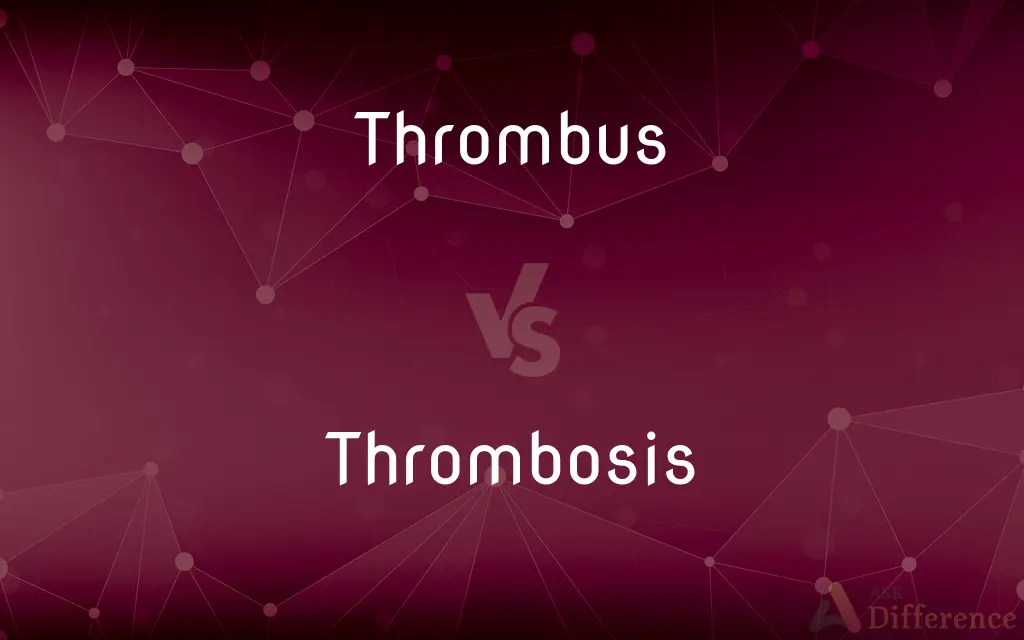Thrombus vs. Thrombosis — What's the Difference?
By Tayyaba Rehman — Updated on November 7, 2023
A thrombus is a blood clot that forms in a vessel, while thrombosis refers to the process of a blood clot forming.

Difference Between Thrombus and Thrombosis
Table of Contents
ADVERTISEMENT
Key Differences
A thrombus is a solid mass of platelets, fibrin, and other blood components that adheres to the interior wall of a blood vessel or the heart. It is a product of the coagulation process and can become a dangerous blockage. Thrombosis, on the other hand, is the pathophysiological process that leads to the formation of a thrombus. It can happen in both arteries and veins and has various triggers including endothelial injury, stasis, or hypercoagulability, collectively known as Virchow's triad.
Thrombus formation is often a localized process that results in the development of a semi-solid blood clot within the cardiovascular system. It's a physical presence that can be observed through medical imaging or pathological examination. Thrombosis is a broader term that describes a series of events, such as coagulation and platelet aggregation, which result in the development of a thrombus. Thrombosis can lead to medical conditions such as stroke, myocardial infarction, or deep vein thrombosis depending on the location and severity of the clot.
When discussing a thrombus, one typically refers to its size, location, and composition. These factors determine the potential risk a thrombus poses to health, as larger clots or those located in critical areas can cause significant problems. Thrombosis is not described in such terms; instead, it is characterized by the dynamic process and the factors contributing to the risk of thrombus formation, such as genetics, lifestyle, and other health conditions.
The presence of a thrombus can be symptomatic or asymptomatic, with symptoms dependent on the clot's interference with normal blood flow. In contrast, thrombosis may not be directly associated with immediate symptoms until a thrombus has formed that significantly affects circulation or breaks free, leading to embolism.
Medical interventions aim to prevent thrombosis through medication, lifestyle changes, or surgery. When a thrombus is already formed, treatments may involve anticoagulants, thrombolytics, or surgical removal of the clot. These therapeutic approaches specifically target the existing thrombus or the process of thrombosis, respectively, with the goal of reducing the risk of further complications.
ADVERTISEMENT
Comparison Chart
Definition
A solid blood clot in a vessel
The process of clot formation
Nature
A physical object
A biological process
Diagnosis
Identified via imaging tests
Diagnosed by clinical signs/symptoms
Treatment
May require removal or dissolution
Focuses on prevention/stoppage of process
Complications
Can cause embolism if moves
Can result in various clot-related conditions
Compare with Definitions
Thrombus
A thrombus forms when blood changes from a liquid to a semi-solid state.
The cardiologist explained that a thrombus could lead to a heart attack.
Thrombosis
A pathological condition where clots form abnormally in the circulatory system.
Preventing thrombosis is crucial in patients with atrial fibrillation.
Thrombus
A thrombus consists of a clotted mass of blood cells and coagulation proteins.
The presence of a thrombus in his coronary artery required immediate intervention.
Thrombosis
Thrombosis involves the disruption of blood flow caused by clotted blood.
Post-surgery, the risk of thrombosis is elevated.
Thrombus
An aggregation of blood factors, primarily platelets and fibrin, causing vascular obstruction at its site of formation.
The surgeon removed a thrombus during the procedure.
Thrombosis
Thrombosis is often the result of a combination of blood stasis, vessel injury, and hypercoagulability.
His prolonged immobility after the injury led to thrombosis.
Thrombus
A clot that develops and persists in the blood vessels or heart.
The thrombus was at risk of detaching and causing an embolism.
Thrombosis
Thrombosis occurs when blood clots obstruct veins or arteries.
Thrombosis in the brain's vessels can lead to a stroke.
Thrombus
A thrombus is a stationary blood clot within the circulatory system.
The ultrasound revealed a thrombus in her leg vein.
Thrombosis
Thrombosis is the formation or presence of a blood clot in a blood vessel.
She was diagnosed with deep vein thrombosis after her long flight.
Thrombus
A thrombus, colloquially called a blood clot, is the final product of the blood coagulation step in hemostasis. There are two components to a thrombus: aggregated platelets and red blood cells that form a plug, and a mesh of cross-linked fibrin protein.
Thrombosis
Thrombosis (from Ancient Greek θρόμβωσις thrómbōsis "clotting”) is the formation of a blood clot inside a blood vessel, obstructing the flow of blood through the circulatory system. When a blood vessel (a vein or an artery) is injured, the body uses platelets (thrombocytes) and fibrin to form a blood clot to prevent blood loss.
Thrombus
A fibrinous clot formed in a blood vessel or chamber of the heart.
Thrombosis
The formation, presence, or development of a thrombus.
Thrombus
A blood clot formed from platelets and other elements that forms in a blood vessel in a living organism, and causes thrombosis or obstruction of the vessel at its point of formation or travel to other areas of the body.
Thrombosis
(pathology) The formation of thrombi in the blood vessels of a living organism, causing obstruction of the circulation.
Thrombus
A clot of blood formed of a passage of a vessel and remaining at the site of coagulation.
Thrombosis
The obstruction of a blood vessel by a clot formed at the site of obstruction; - distinguished from embolism, which is produced by a clot or foreign body brought from a distance.
Thrombus
A blood clot formed within a blood vessel and remaining attached to its place of origin
Thrombosis
The formation or presence of a thrombus (a clot of coagulated blood attached at the site of its formation) in a blood vessel
Common Curiosities
Can a thrombus move?
Typically, a thrombus stays at its formation site, but parts can break off, forming an embolus.
How is a thrombus detected?
A thrombus is often detected through imaging tests like ultrasound or MRI.
What causes thrombosis?
Thrombosis can be caused by damaged blood vessels, blood flow issues, or hypercoagulability.
Are thrombosis and embolism the same?
No, thrombosis refers to clot formation, while embolism refers to a clot moving and blocking another vessel.
How can I prevent a thrombus?
Preventing a thrombus includes managing risk factors, like maintaining mobility and taking prescribed medications.
What are the symptoms of a thrombus?
Symptoms can include swelling, pain, and discoloration in the affected area.
What is a thrombus?
A thrombus is a solid blood clot fixed within the circulatory system.
What lifestyle changes can reduce thrombosis risk?
Regular exercise, a healthy diet, and avoiding smoking can reduce the risk of thrombosis.
Is a thrombus more common in veins or arteries?
A thrombus can occur in both, but it is more common in veins.
What is thrombosis?
Thrombosis is the process of clot formation within blood vessels.
Does a thrombus always cause symptoms?
No, a thrombus can be asymptomatic, especially if it's small.
Is thrombosis treatable?
Yes, thrombosis can be treated with anticoagulants, thrombolytics, or sometimes surgery.
Can thrombosis be a medical emergency?
Yes, especially when it leads to heart attack, stroke, or pulmonary embolism.
Can thrombosis occur anywhere in the body?
Thrombosis can occur in any blood vessel but is more common in the legs (DVT) and lungs (PE).
How is thrombosis diagnosed?
It is diagnosed based on symptoms, physical examination, and diagnostic tests like blood tests or Doppler studies.
Share Your Discovery

Previous Comparison
Gum vs. Glue
Next Comparison
Anterior vs. PosteriorAuthor Spotlight
Written by
Tayyaba RehmanTayyaba Rehman is a distinguished writer, currently serving as a primary contributor to askdifference.com. As a researcher in semantics and etymology, Tayyaba's passion for the complexity of languages and their distinctions has found a perfect home on the platform. Tayyaba delves into the intricacies of language, distinguishing between commonly confused words and phrases, thereby providing clarity for readers worldwide.














































